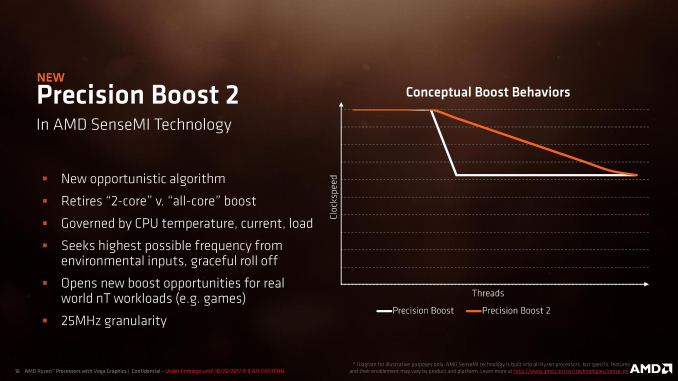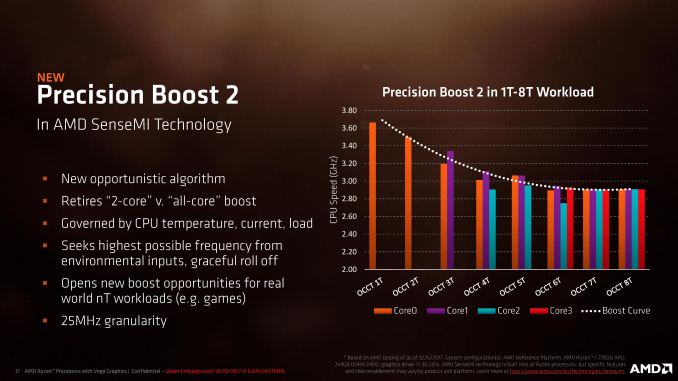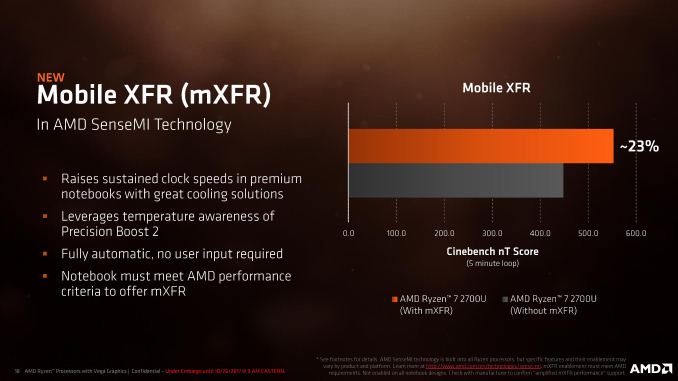Ryzen Mobile is Launched: AMD APUs for Laptops, with Vega and Updated Zen
by Ian Cutress on October 26, 2017 9:00 AM ESTSense Me Ryzen: Better Boost
When AMD launched the desktop Zen processors, it also branded a series of five technologies under the ‘SenseMI’ name. We covered these in detail in our Ryzen 7 review, but in short, it covers the following:
- Pure Power: Sensors to optimize power consumption
- Precision Boost: Determines how Turbo is applied
- Extreme Frequency Range: Going above maximum turbo when possible
- Neural Net Prediction: Using Neural Nets for prefetching data
- Smart Prefetch: Algorithms that work to enhance prefetch
With Ryzen Mobile, the features relating to frequency get an updated model, while Pure Power gets a bigger boost. We’ll cover the power changes on the next page, but it is worth talking about how AMD has improved Precision Boost and brought XFR to laptops.
Precision Boost 2
Most CPU turbo algorithms work by sensing how many cores and threads are under load, determining if the CPU has enough power headroom, and applying a voltage. This is why in the past both of the major x86 CPU manufacturers will quote a ‘per-core turbo frequency’ to show what the frequency should be when different numbers of cores are loaded and all else is fine (there is temperature/power headroom).
For Ryzen Mobile, AMD is pivoting to a new turbo model. When the system is in the P0 (top) turbo state, the system will use a new opportunistic turbo algorithm that rather than being based on the cores under load, is governed by CPU temperatures, currents, and how much load is being applied. The algorithm takes into account all the environmental inputs, such as skin temperature sensors and battery life, and will provide the best turbo frequency it can, regardless of if one thread is being used or all threads are being used.
It will be able to provide boost amounts at the 25 MHz granularity level, similar to how the desktop processors work, with the idea being that in most cases, if the system has a lot of cores available and a background process performs some very light work (such as checking for updates), rather than dropping 500-800 MHz because more cores are loaded, the system will keep at the high frequency.
AMD is stating that this has a big effect on real-world workloads, typically those that have variable thread workloads such as gaming.
When asked if Precision Boost 2 would be coming to the next generation of AMD’s Desktop Ryzen processors, I was told that ‘it could be inferred / it’s a safe bet’.
Mobile Extended Frequency Range (mXFR)
Because mobile systems are thermally limited, battery limited, power limited, and battery limited, offering ‘extra’ turbo headroom is not really something that processor manufacturers like to do. As a result, most of the Ryzen Mobile-powered notebooks will not have any form of XFR – AMD will be allowing it on a case-by-case basis for vendors that overengineer their chassis to be capable of supporting a higher power profile.
This feature essentially extends the average level at which Precision Boost 2 will operate, and also marks what could be considered a higher configurable TDP. One of the systems being launched with Ryzen Mobile this side of Christmas will be mXFR enabled, because the chassis is designed for 25W rather than 15W. It is worth noting that AMD states the configurable TDP of the Ryzen Mobile chips goes up to 25W, so this is likely the case what is happening.
Encode and Decode
AMD is fully using Vega’s encode and decode capabilities with Ryzen Mobile. The big inclusion for AMD’s mobile devices is the ability to decode VP9, the codec prefered in particular by YouTube.
| AMD Ryzen Mobile Encode/Decode Capabilities | |||||
| Decode 1080p @ 4:2:0 |
Decode 2160p @ 4:2:0 |
Encode 1080p |
Encode 1440p |
Encode 2160p |
|
| MPEG2 | 60 FPS | - | |||
| VC1 | 60 FPS | - | |||
| VP9 8/10 bpc | 240 FPS | 60 FPS | |||
| H.264 8 bpc | 240 FPS | 60 FPS | 120 FPS | 60 FPS | 30 FPS |
| H.264 10 bpc | 240 FPS | 60 FPS | |||
| HEVC 8bpc | 240 FPS | 60 FPS | 120 FPS | 60 FPS | 30 FPS |
| HEVC 10 bpc | 240 FPS | 60 FPS | |||
| JPEC 8bpc | 240 FPS | 60 FPS | |||













140 Comments
View All Comments
xemone - Thursday, October 26, 2017 - link
This is impressive and I'm glad to see AMD chips that can finally compete with Intel in the low TDP range. I am however, disappointed LPDDR4 compatibility isn't included in the initial parts.But these are only the first two and there are more to come, so I'm hopeful we'll see chips that support power-sipping memory. Any 15W TDP chip intended for the the ultrathin mobile market should at least allow for LP-DRAM. Let's not forget Intel has opened up Thunderbolt 3 and made it royalty-free. Adding these two technologies to AMDs Infinity Fabric "interconnect" onboard Raven Ridge would allow manufacturers to build sleeker devices. Board space is at a serious premium and that often why its hard to find low power AMD chips in these premium thin and lights.
Things are about to change!
sonichedgehog360@yahoo.com - Thursday, October 26, 2017 - link
“If we look at processors from Intel that are 4C/8T, like the 35W Core i7-7700T, this scores 777 in our testing, which kind of drives away from AMD’s point here. AMD succeeds in touting that it has ‘desktop-class performance’ in a small power package, attempting to redefine its status as high performance. Part of me thinks at this level, it could be said that all the mobile processors in this range have ‘desktop-class performance’, so this is a case of AMD now catching up to the competition.“You just said that in Cinebench R15, AMD’s Ryzen 7 2700U achieved 707 at 15W and compare it to a 35W Intel product that achieved 777. But you call this catching up; I would call that blowing past the competition! That score is nearly double the performance per watt, considering that you just compared AMD’s product with 15W TDP with an Intel product with a 35W TDP.
sonichedgehog360@yahoo.com - Thursday, October 26, 2017 - link
Looking more closely, a 15W Ryzen 7 2700U appears to fall right in line with an Intel Skull Canyon NUC’s 45W Intel Core i7-6700HQ in CPU performance and slightly outperforms it in GPU performance. Per the official AnandTech review, the Skull Canyon NUC got a Cinebench R15 ST/MT score of 148.24/711.04. Per NotebookCheck, its Iris Pro Graphics 580 achieves a score of 3510 in 3DMark 11 - Performance.SaturnusDK - Thursday, October 26, 2017 - link
I was similarly perplexed by the wording used here. How is more than double the performance per watt "catching up". The examples have the i7-7700T score 22.2 points per watt while the R7 2700U completely annihilates that by 47.1 point per watt. Seems to me that it is Intel that has a lot of catching up to do.sonichedgehog360@yahoo.com - Thursday, October 26, 2017 - link
It could be a combination of years of Intel having a lion’s share of the media mindshare (before Ryzen, for the longest time, the fact of the matter was that Intel was far and away the superior architecture) combined with the fact that there may have been very limited time given between receipt date and embargo time, giving way to more errors cropping up in a highly rushed journalism process.extide - Friday, October 27, 2017 - link
Yeah, but that 35W part could sustain that performance for a much longer time, if not indefinitely. The 15W AMD part (and likewise 15W Intel parts) will throttle down a fair bit after sustained use. According to AMD the R7 2700U drops to ~550 on cinebench after a 5-min loop. (Last slide on page 3)SaturnusDK - Friday, October 27, 2017 - link
It's possible it could sustain it for longer. We don't know that though. And even 550 points is still a massive performance per watt advantage to the AMD part. 770 points at 35W is 22 points per watt while 550 points (sustained) at 15W is 36.67 points per watt. A whooping 66.7% performance per watt advantage.lilmoe - Thursday, October 26, 2017 - link
I probably missed this, but any word on bulk pricing in comparison with Intel U series?Other than that, I'm pretty damn sure the 14nm LPP will shine at the 15w and lower power envelopes. This is where the power per watt comparisons matter for consumers. Same should be applicable to mobile Vega. I wonder if pairing the APU with a discreet mobile Vega part would have any advantages over an Intel/nVidia pair. Hopefully it would have better harmony and better switching drivers.
I would also love to see benchmarks emphasising latency vs Intel speed shift. I just hate to admit Intel might have an advantage there.
Too early to tell, but boy am I excited since what feels like ages.
Kamen75 - Thursday, October 26, 2017 - link
Samsung's 14nm LPP process being leased by GF just doesn't do Ryzen and Vega much justice on high performance desktop parts. Given 14nm LPP's smartphone SoC heritage it sure does let these low power AMD designs shine though. I'm also anticipating great things from IBM's 7nm process so long as it isn't delayed for an extra year. Bring on the 4.5 - 6 watt fanless APU's.I too am excited for the first time in years.
lilmoe - Thursday, October 26, 2017 - link
Fingers crossed for 6 or even 8 cores Zen2 and 14-16 CUs at 7nm, with higher max clocks for ST. HBM would be the icing on the cake. Throw a dGPU with twice or thrice the CUs and put your hand in my pocket and help yourself to my wallet AMD.